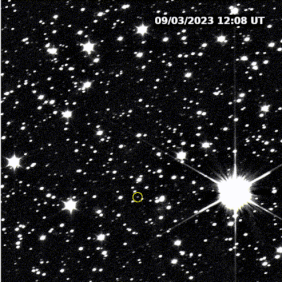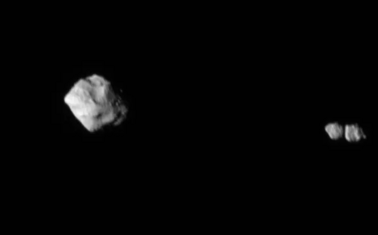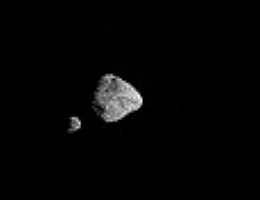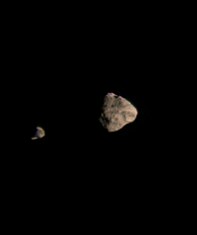152830 Dinkinesh
 Dinkinesh and its satellite Selam imaged by the Lucy spacecraft's L'LORRI camera | |
| Discovery[1] | |
|---|---|
| Discovered by | LINEAR |
| Discovery site | Lincoln Lab ETS |
| Discovery date | 4 November 1999 |
| Designations | |
| (152830) Dinkinesh | |
| Pronunciation | /ˈdɪŋkɪnɛʃ/ |
Named after | Dinkʼinesh (Lucy fossil) |
| 1999 VD57 · 2004 HJ78 · 2007 CB63[2] | |
| main-belt[1] · (inner) | |
| Orbital characteristics [1] | |
| Epoch 25 February 2023 (JD 2460000.5) | |
| Uncertainty parameter 0 | |
| Observation arc | 23.06 yr (8,422 days) |
| Earliest precovery date | 15 October 1999 |
| Aphelion | 2.437 AU |
| Perihelion | 1.946 AU |
| 2.191 AU | |
| Eccentricity | 0.1120 |
| 3.24 yr (1,185 days) | |
| 25.239° | |
| 0° 18m 13.874s / day | |
| Inclination | 2.094° |
| 21.380° | |
| 66.711° | |
| Known satellites | 1 |
| Physical characteristics | |
| 790 m (primary)[3] | |
| 3.7387±0.0013 h[4] | |
| 0.27+0.25 −0.06[5] | |
| Sq[6][7] V–R = 0.455±0.025[8] | |
| 17.62±0.04 (V-band)[6][8]: L3 | |
152830 Dinkinesh (provisional designation 1999 VD57) is a binary main-belt asteroid about 790 meters (2,600 feet) in diameter. It was discovered by the Lincoln Near-Earth Asteroid Research (LINEAR) survey at Socorro, New Mexico on 4 November 1999. Dinkinesh, the name borrowed from an Ethiopian word for the Lucy fossil, was the first flyby target of NASA's Lucy mission, which approached 425 km (264 mi) from the asteroid on 1 November 2023.[9] During the flyby, the Lucy spacecraft discovered that Dinkinesh has a contact-binary natural satellite, named Selam, which is 220 meters (720 ft) in diameter. Dinkinesh is the smallest main-belt asteroid explored by spacecraft yet, though some smaller near-Earth asteroids have also been explored.
Discovery and observational history
[edit]Dinkinesh was discovered on 4 November 1999 by the Lincoln Near-Earth Asteroid Research (LINEAR) sky survey at Socorro, New Mexico.[2] The discovery observations were published by the Minor Planet Center (MPC) on 23 November 1999 and the asteroid was given the minor planet provisional designation 1999 VD57, which describes its discovery year, month, and discovery order within the month.[10] The LINEAR and Spacewatch (Kitt Peak, Arizona) surveys continued observing Dinkinesh until 15 November 1999, after which the asteroid became lost and went unrecognized for years.[2]
On 19 April 2004, Spacewatch reobserved Dinkinesh as a seemingly new asteroid, but misattributed these observations to those of another unrelated asteroid, 2004 GZ43, which was discovered by the same survey on 12 April 2004.[2][11] Dinkinesh was again reobserved as a seemingly new asteroid on 15 and 17 February 2007 by Palomar Observatory's Near-Earth Asteroid Tracking (NEAT) survey at San Diego County, California, which led the MPC to give Dinkinesh the provisional designation 2007 CB63 on 25 February 2007.[2][12] Gareth V. Williams, the associate director of the MPC at the time, recognized that 1999 VD57 and 2007 CB63 were the same asteroid and published the linkage on 2 March 2007.[13][14] The linkage between Dinkinesh's 1999 and 2007 observations enabled the MPC to find additional observations from 2001–2007, where the asteroid was previously detected unknowingly.[15][16] The linkage and additional observations extended Dinkinesh's observation arc to over 7 years and greatly reduced uncertainties in its orbit. This allowed the MPC to give Dinkinesh its permanent minor planet catalog number 152830 on 2 April 2007.[17][14] Pre-discovery LINEAR observations of Dinkinesh from 15 October 1999 were later identified and published on 19 August 2007, extending the observation arc by another 5 years.[18]
On 3 March 2007, the MPC established that Spacewatch's 2004 observations of Dinkinesh were not of 2004 GZ43, and thus redesignated these observations as 2004 HJ78.[19] However, the MPC did not recognize that 2004 HJ78 was Dinkinesh until Gareth Williams made the linkage and published it on 9 February 2009.[20]
Name
[edit]Dinkinesh is the Ethiopian name for the Lucy fossil, after which NASA's Lucy mission is named.[21] The name means "you are wonderful" in the Amharic language (ድንቅነሽ).[22][23] "Din(i)k’i" means "wonderful"[24] and "nesh" means "you are" in feminine form of this pronoun and verb.[25] The asteroid was unnamed when it was selected for exploration by the Lucy spacecraft, so the Lucy mission team proposed the name Dinkinesh to the International Astronomical Union's Working Group for Small Bodies Nomenclature (WGSBN), which approved and announced the name on 6 February 2023.[21][22]
Orbit
[edit]Dinkinesh orbits the Sun in the inner main asteroid belt on an elliptical orbit with an average distance of 2.19 astronomical units (328 million km, 204 million mi) and an orbital period of 3.24 years.[1] With an orbital eccentricity of 0.112, Dinkinesh comes as close as 1.95 AU (292 million km; 181 million mi) from the Sun at perihelion to as far as 2.44 AU (365 million km; 227 million mi) at aphelion.[1] The asteroid's orbit is inclined 2.1° with respect to the plane of the Solar System.[1] Dinkinesh is possibly a member of the Flora family, a group of asteroids that share similar orbital characteristics as the family's parent asteroid 8 Flora.[5]: 5
Exploration
[edit]The Lucy spacecraft made a flyby of Dinkinesh from a distance of 425 km (264 mi) on 1 November 2023 16:54 UTC.[26] Lucy's flyby of Dinkinesh was announced by NASA and the Lucy science team on 25 January 2023, more than one year after Lucy had launched in October 2021.[27] The asteroid was initially overlooked as a potential flyby target because it was too small.[27] It was identified in August 2022 by Raphael Marschall, mission collaborator of the Nice Observatory, who investigated 500,000 asteroids for potential close approaches with the spacecraft.[27][28] The original trajectory of Lucy took it within 64,000 km (40,000 mi) of Dinkinesh, but a series of planned trajectory correction maneuvers from May to September 2023 allowed Lucy to approach much closer.[27][29][30]
Dinkinesh was Lucy's first and smallest asteroid flyby during its mission, and is the smallest main-belt asteroid explored by spacecraft yet.[27] The Dinkinesh flyby served to test Lucy's autonomous tracking capabilities before it will apply them to its main science targets, the Jupiter trojans.[27][31] Lucy took its first images of Dinkinesh on 3–5 September 2023, when the asteroid was 23 million km (14 million mi) away from the spacecraft.[9] The spacecraft continued imaging Dinkinesh from afar to aid its optical navigation over the days before the flyby.[9] Because Dinkinesh is very small, Lucy did not resolve surface detail on Dinkinesh until the day of the flyby.[9] At closest approach, Lucy was moving 4.5 km/s (2.8 mi/s) relative to Dinkinesh and it was expected to take 2 meters/pixel resolution images of the asteroid with the panchromatic L'LORRI imager, 15 m/pixel color images with the L'Ralph imager, and 24 m/pixel near-infrared spectra and thermal measurements with the L'TES spectrometer.[9][31] After the flyby, Lucy's L'LORRI instrument continued observing Dinkinesh for four days to measure the asteroid's light curve.[26]
Satellite
[edit]
 | |
| Discovery | |
|---|---|
| Discovered by | Lucy |
| Discovery date | 27 November 2023 |
| Designations | |
| Pronunciation | /səˈlɑːm/ |
| Dinkinesh I S/2023 (152830) 1 | |
| Orbital characteristics[32][4] | |
| 3.11±0.05 km | |
| Eccentricity | ≈0 |
| 52.67±0.04 h | |
| Satellite of | Dinkinesh |
| Physical characteristics[32][4] | |
| Dimensions | 240 m × 200 m × 200 m (inner lobe) 280 m × 220 m × 210 m (outer lobe) |
| 220 m | |
| 52.44±0.14 h (likely synchronous) | |
During the flyby, the Lucy spacecraft discovered that Dinkinesh has a natural satellite 220 m (720 ft) in diameter.[3] The satellite is named Selam (/səˈlɑːm/; full designation Dinkinesh I Selam), after the fossil remains of a three-year-old Australopithecus afarensis female hominin (the same species as the Lucy fossil) found in Dikika, Ethiopia in 2000.[33]: 5 Selam means "peace" in the Amharic language (ሰላም) and it was proposed by Raphael Marschall.[34] The name was approved by the International Astronomical Union's WGSBN on 27 November 2023.[34][33]: 5
Together, Dinkinesh and Selam form a binary asteroid system. Dinkinesh is the second binary main-belt asteroid explored by spacecraft, after 243 Ida by Galileo in 1993. The Dinkinesh binary system resembles the 65803 Didymos near-Earth asteroid binary system in size and composition, but differs in location from the Sun, which allows scientists to compare the nature of binary asteroids in different environments.[35][36] In the weeks prior to the flyby, the Lucy spacecraft found that Dinkinesh's brightness did not vary as predicted, which provided the first hints of Dinkinesh's binary nature.[3][37] Images of Selam taken after Lucy's approach revealed that it is a contact binary with two lobes attached to each other. While contact binary asteroids are common in the Solar System, Selam is the first known example of a contact binary satellite of an asteroid.[38]
Origin
[edit]Selam is expected to have a similar origin as the satellites of rubble pile asteroids, which are thought to have originated from mass shedding events from the primary body in the past.[39][36] These mass shedding events occur when the asteroid rotates fast enough that material accumulates along the equator and becomes ejected into orbit by the centrifugal force.[39][40] The ejected material forms a disk around the asteroid, which eventually coalesces into a satellite.[39] The uneven reflection of sunlight off an asteroid's surface, which is called the Yarkovsky–O'Keefe–Radzievskii–Paddack (YORP) effect, is responsible for rotationally accelerating asteroids to the point of mass shedding.[39] During a mass shedding event, the asteroid's angular momentum is transferred to its ejected material, which slows down the asteroid's rotation rate as a result.[39]
One possible explanation for the origin of Selam's contact binary nature is rotational fissioning by the YORP effect.[41][42] In this scenario, the fissioned satellite is split into two separate satellites in orbit around Dinkinesh, making it a triple asteroid system. This triple asteroid system is unstable due to chaotic gravitational perturbations between the satellites, and eventually leads to one of the satellites colliding with either the primary asteroid or the other satellite.[41]: 170 If the collision between two satellites occurs at slow enough speeds (less than 50 mm/s or 2.0 in/s), the impact does not disrupt the shapes of the two bodies and instead forms a contact binary.[41]: 167
Physical characteristics
[edit]Geology
[edit]
The surfaces of Dinkinesh and Selam are covered with boulders and craters.[39] The outline of Dinkinesh's shape is not smooth, which suggests that the asteroid is relatively old.[35] Dinkinesh bears an equatorial ridge, which suggests that the asteroid has experienced mass shedding in the past.[39] Dinkinesh's equatorial ridge also has a secondary ridge that branches off it.[35] Dinkinesh's shape resembles the near-Earth asteroids 101955 Bennu and 162173 Ryugu, which are known to have rubble pile interior structures consisting of rocks and dust loosely held by gravity. Because of this similarity, Dinkinesh is thought to likely have a rubble pile structure as well.[39]
A ridge is also present on Selam, but it is not oriented along its equator.[35] The reason for Selam's unaligned ridge remains yet to be determined.[35]
Surface composition
[edit]
Visible light spectroscopy of Dinkinesh by two independent teams of researchers in November–December 2022 showed that it is an S-type asteroid, meaning it is mainly composed of rocky silicates and small amounts of metal.[7]: 1 [6] Spectral data obtained from the 10-meter Keck I telescope at Mauna Kea, Hawaii indicates that Dinkinesh belongs to the Sq subclass of S-type asteroids because it exhibits the 1 μm olivine and pyroxene spectral absorption band that is characteristically seen in Q-type asteroids.[6][43]: 4, 6 On the other hand, spectral data from the 8.1-meter Gemini South telescope at Cerro Pachón, Chile showed that Dinkinesh's spectrum more closely resembles a standard S-type asteroid with a shallower 1 μm band.[6] This difference between the two measured spectra of Dinkinesh may be caused by either observational artifacts or compositional variations across Dinkinesh's surface as it rotates.[6] If the latter possibility is true, then Dinkinesh's varying 1 μm band would indicate that there is space-weathered material that is unevenly distributed across its surface, likely due to impacts and surface topography.[6]
Rotation and light curve
[edit]Dinkinesh rotates every 3.7387±0.0013 h. As Dinkinesh rotates, its brightness from Earth fluctuates due to its non-spherical shape, which can be inferred from the amplitude of the asteroid's rotational light curve.[44][8] The first photometric observations of Dinkinesh's rotational light curve were attempted with the Teide Observatory's 0.8-m IAC-80 telescope at Tenerife, Spain in November 2022, but it did not observe Dinkinesh long enough to make conclusive findings.[7]: 4 Longer photometric observations of Dinkinesh were made with the Calar Alto Observatory's 1.23-m telescope at Almería, Spain from November 2022–February 2023, which discovered that Dinkinesh rotates slowly and had a light curve amplitude of 0.39±0.02 magnitudes.[44][8]: 1
Diameter and albedo
[edit]Lucy images of Dinkinesh show that it measures approximately 790 m (2,590 ft) across its equator.[3][39] This is in agreement with the previous diameter estimates from measured absolute magnitude and average S-type asteroid albedo.[6][7][8] Reprocessing of archival infrared thermal emission observations by the Wide-field Infrared Survey Explorer (WISE) from March 2010 give a consistent result.[5][39]
See also
[edit]- 52246 Donaldjohanson, Lucy's next flyby target in 2025
- List of minor planets and comets visited by spacecraft
References
[edit]- ^ a b c d e f "JPL Small-Body Database Browser: 152830 Dinkinesh (1999 VD57)" (2022-11-05 last obs.). Jet Propulsion Laboratory. Archived from the original on 18 November 2022. Retrieved 25 January 2023.
- ^ a b c d e "(152830) Dinkinesh = 2004 HJ78 = 1999 VD57 = 2007 CB63". Minor Planet Center. Archived from the original on 13 March 2023. Retrieved 25 January 2023.
- ^ a b c d Kretke, Katherine (2 November 2023). "NASA's Lucy Spacecraft Discovers 2nd Asteroid During Dinkinesh Flyby". NASA. Archived from the original on 3 November 2023. Retrieved 2 November 2023.
- ^ a b c Levison, Harold F.; Marchi, Simone; Noll, Keith S.; et al. (29 May 2024). "A contact binary satellite of the asteroid (152830) Dinkinesh". Nature. 629 (8014): 1015–1020. arXiv:2406.19337. Bibcode:2024Natur.629.1015L. doi:10.1038/s41586-024-07378-0. PMC 11136651. PMID 38811709.
- ^ a b c McFadden, Kiana D.; Mainzer, Amy K.; Masiero, Joseph R.; Bauer, James M.; Cutri, Roc M.; Dahlen, Dar; et al. (November 2023). "Size and Albedo Constraints for (152830) Dinkinesh Using WISE Data". Astrophysical Journal Letters. 957 (1): 6. arXiv:2309.13158. Bibcode:2023ApJ...957L...2M. doi:10.3847/2041-8213/acff61. L2.
- ^ a b c d e f g h Bolin, B. T.; Noll, K. S.; Caiazzo, I.; Fremling, C.; Binzel, R. P. (August 2023). "Keck and Gemini spectral characterization of Lucy mission fly-by target (152830) Dinkinesh". Icarus. 400. arXiv:2303.08130. Bibcode:2023Icar..40015562B. doi:10.1016/j.icarus.2023.115562. S2CID 257505087. 115562.
- ^ a b c d de León, J.; Licandro, J.; Pinilla-Alonso, N.; Moskovitz, N.; Kareta, T.; Popescu, M.; et al. (April 2023). "Characterisation of the new target of the NASA Lucy mission: asteroid 152830 Dinkinesh (1999 VD57)". Astronomy & Astrophysics. 672: 4. arXiv:2303.05918. Bibcode:2023A&A...672A.174D. doi:10.1051/0004-6361/202346278. A174.
- ^ a b c d e Mottola, Stephano; Denk, Tilmann; Marchi, Simone; Binzel, Richard P.; Noll, Keith S.; Spencer, John R.; Levison, Harold F. (September 2023). "Characterizing asteroid (152830) Dinkinesh in preparation for the encounter with the NASA Lucy mission: a photometric study". Monthly Notices of the Royal Astronomical Society: Letters. 524 (1): L1–L4. Bibcode:2023MNRAS.524L...1M. doi:10.1093/mnrasl/slad066.
- ^ a b c d e Kretke, Katherine (11 September 2023). "NASA's Lucy Spacecraft Captures its 1st Images of Asteroid Dinkinesh". NASA. Archived from the original on 15 September 2023. Retrieved 12 September 2023.
- ^ "M. P. S. 7496" (PDF). Minor Planet Circulars Supplement. Minor Planet Center. 23 November 1999. p. 284. Archived (PDF) from the original on 13 September 2023. Retrieved 13 September 2023.
- ^ "M. P. S. 105236" (PDF). Minor Planet Circulars Supplement. Minor Planet Center. 25 April 2004. p. 414. Archived (PDF) from the original on 28 August 2017. Retrieved 13 September 2023.
- ^ "M. P. S. 200485" (PDF). Minor Planet Circulars Supplement. Minor Planet Center. 25 February 2007. p. 253. Archived (PDF) from the original on 4 October 2017. Retrieved 13 September 2023.
- ^ "MPEC 2007-E01 : DAILY ORBIT UPDATE (2007 MAR. 2 UT)". Minor Planet Electronic Circulars. Minor Planet Center. 2 March 2007. Archived from the original on 8 November 2023. Retrieved 13 September 2023.
- ^ a b "M. P. O. 116514" (PDF). Minor Planet Circulars Orbit Supplement. Minor Planet Center. 2 April 2007. p. 96. Archived (PDF) from the original on 14 September 2016. Retrieved 13 September 2023.
- ^ "M. P. S. 201406" (PDF). Minor Planet Circulars Supplement. Minor Planet Center. 3 March 2007. p. 10. Archived (PDF) from the original on 4 October 2017. Retrieved 13 September 2023.
- ^ "M. P. O. 115681" (PDF). Minor Planet Circulars Orbit Supplement. Minor Planet Center. 3 March 2007. p. 839. Archived (PDF) from the original on 14 September 2016. Retrieved 13 September 2023.
- ^ "M. P. C. 59323" (PDF). Minor Planet Circulars. Minor Planet Center. 2 April 2007. p. 47. Archived (PDF) from the original on 14 August 2016. Retrieved 13 September 2023.
- ^ "M. P. O. 213622" (PDF). Minor Planet Circulars Supplement. Minor Planet Center. 19 August 2007. p. 620. Archived (PDF) from the original on 14 September 2016. Retrieved 13 September 2023.
- ^ "M. P. C. 58994" (PDF). Minor Planet Circulars. Minor Planet Center. 3 March 2007. p. 4. Archived (PDF) from the original on 28 August 2017. Retrieved 13 September 2023.
- ^ "M. P. C. 64979" (PDF). Minor Planet Circulars. Minor Planet Center. 9 February 2007. p. 9. Archived (PDF) from the original on 28 August 2017. Retrieved 13 September 2023.
- ^ a b Foust, Jeff (26 January 2023). "NASA adds asteroid flyby to Lucy mission". SpaceNews. Archived from the original on 8 November 2023. Retrieved 26 January 2023.
- ^ a b "WGSBN Bulletin 3, #2" (PDF). WGSBN Bulletin. 3 (2). International Astronomical Union: 22. 6 February 2023. Archived (PDF) from the original on 6 February 2023. Retrieved 6 February 2023.
- ^ Kretke, Katherine (1 March 2023). "Introducing "Dinkinesh" – First Asteroid Target for NASA's Lucy Mission Gets a Name". SciTechDaily. Archived from the original on 2 March 2023. Retrieved 2 March 2023.
- ^ "How to Say Wonderful in Amharic". Archived from the original on 29 October 2023. Retrieved 29 October 2023.
- ^ "Helpful Amharic Words & Phrases" (PDF). Archived (PDF) from the original on 29 October 2023. Retrieved 29 October 2023.
- ^ a b Morton, Erin (1 November 2023). "NASAs Lucy Spacecraft Hours Away from 1st Asteroid Encounter". NASA Blogs. NASA. Archived from the original on 2 November 2023. Retrieved 1 November 2023.
- ^ a b c d e f Evans, Jessica (25 January 2023). "NASA's Lucy Team Announces New Asteroid Target". NASA. Archived from the original on 25 January 2023. Retrieved 25 January 2023.
- ^ Spencer, J.; Levison, H.; Marchi, S.; Noll, K.; Salmon, J.; Marschall, R.; et al. (October 2023). The Lucy Encounter with (152830) Dinkinesh. 55th Annual DPS Meeting Joint with EPSC. Vol. 55. San Antonio, Texas. 102.06. Archived from the original on 8 November 2023. Retrieved 2 October 2023.
- ^ Morton, Erin (18 May 2023). "NASA's Lucy Spacecraft Adjusts Course for Asteroid Flyby in November". NASA Blogs. NASA. Archived from the original on 28 October 2023. Retrieved 21 October 2023.
- ^ Kretke, Katherine (13 October 2023). "NASA's Lucy Spacecraft Continues Approach to Asteroid Dinkinesh". NASA. Archived from the original on 19 October 2023. Retrieved 21 October 2023.
- ^ a b Spencer, J. R.; Levison, H. A.; Marchi, S.; Salmon, J. J.; Noll, K. S.; Solanki, I.; Olkin, C. A. (June 2023). Planning Close Encounter Science Observations for the Lucy Mission (PDF). Asteroids, Comets, Meteors Conference 2023. Lunar and Planetary Institute. 2456. Archived (PDF) from the original on 14 September 2023. Retrieved 12 September 2023.
- ^ a b "(152830) Dinkinesh and Selam". Johnston's Archive. Wm. Robert Johnston. Retrieved 27 March 2024.
- ^ a b "WGSBN Bulletin 3, #16" (PDF). WGSBN Bulletin. 3 (16). International Astronomical Union: 12. 27 November 2023. Archived (PDF) from the original on 28 November 2023. Retrieved 27 November 2023.
- ^ a b Morton, Erin (29 November 2023). "Satellite Discovered by NASA's Lucy Mission Gets Name". NASA Blogs. NASA. Archived from the original on 30 November 2023. Retrieved 29 November 2023.
- ^ a b c d e Bartels, Meghan (3 November 2023). "NASA Asteroid Mission Discovers Tiny Surprise Moon with 'Really Bizarre' Shape". Scientific American. Archived from the original on 3 November 2023. Retrieved 3 November 2023.
- ^ a b Merrill, Colby; Kubas, Alexia; Meyer, Alex; Raducan, Sabina (2024). "Age of (152830) Dinkinesh I Selam constrained by secular tidal-BYORP theory". Astronomy and Astrophysics. 684: L20. Bibcode:2024A&A...684L..20M. doi:10.1051/0004-6361/202449716.
- ^ "NASA's Lucy Mission Gets an Unexpected Twofer in First Asteroid Encounter". Johns Hopkins University Applied Physics Laboratory. 2 November 2023. Archived from the original on 3 November 2023. Retrieved 2 November 2023.
- ^ Kretke, Katherine (7 November 2023). "NASA's Lucy Surprises Again, Observes 1st-ever Contact Binary Orbiting Asteroid". NASA. Archived from the original on 7 November 2023. Retrieved 7 November 2023.
- ^ a b c d e f g h i j Lakdawalla, Emily (3 November 2023). "Lucy Mission Flies By Asteroid Dinkinesh, Finds a Little Surprise". Sky & Telescope. Archived from the original on 3 November 2023. Retrieved 3 November 2023.
- ^ Hyodo, Ryuki; Sugiura, Keisuke (October 2022). "Formation of Moons and Equatorial Ridge around Top-shaped Asteroids after Surface Landslide". The Astrophysical Journal Letters. 937 (2): 6. arXiv:2209.07045. Bibcode:2022ApJ...937L..36H. doi:10.3847/2041-8213/ac922d. S2CID 252280407. L36.
- ^ a b c Jacobson, Seth A.; Scheeres, Daniel J. (July 2011). "Dynamics of rotationally fissioned asteroids: Source of observed small asteroid systems". Icarus. 214 (1): 161–178. arXiv:1404.0801. Bibcode:2011Icar..214..161J. doi:10.1016/j.icarus.2011.04.009. S2CID 119245876.
- ^ Petersen, Collins (9 November 2023). "What? Wow! That New Asteroid Image from Lucy Just Got Even More Interesting". Universe Today. Archived from the original on 10 November 2023. Retrieved 9 November 2023.
- ^ Palamakumbure, Lakshika; Mizohata, Kenichiro; Flanderová, Kateřina; Korda, David; Penttilä, Antti; Kouhout, Tomáš (April 2023). "Simulation of Space Weathering on Asteroid Spectra through Hydrogen Ion Irradiation of Meteorites". The Planetary Science Journal. 4 (4): 10. Bibcode:2023PSJ.....4...72P. doi:10.3847/PSJ/acc848. hdl:10138/358328. 72.
- ^ a b Mottola, S.; Denk, T.; Marchi, S.; Binzel, R. P.; Noll, K. S.; Spencer, J. R.; Levison, H. F. (June 2023). Pre-Encounter Characterization of the Lucy Target (152830) Dinkinesh (PDF). Asteroids, Comets, Meteors Conference 2023. Lunar and Planetary Institute. 2486. Archived (PDF) from the original on 1 July 2023. Retrieved 23 May 2023.
External links
[edit]- "Flyby of Dinkinesh Simulation". NASA's Eyes on the Solar System. NASA. Archived from the original on 2 November 2023.
- 152830 Dinkinesh at AstDyS-2, Asteroids—Dynamic Site
- 152830 Dinkinesh at the JPL Small-Body Database









